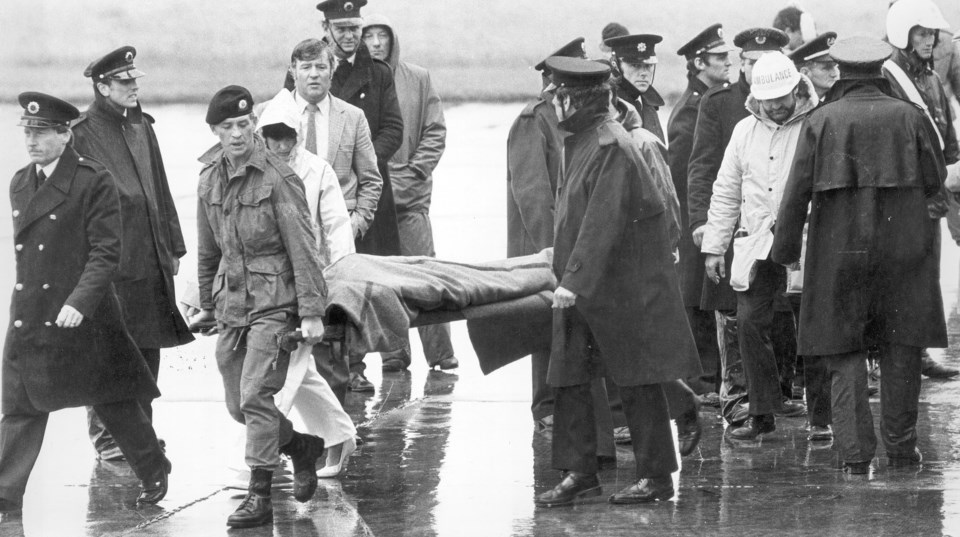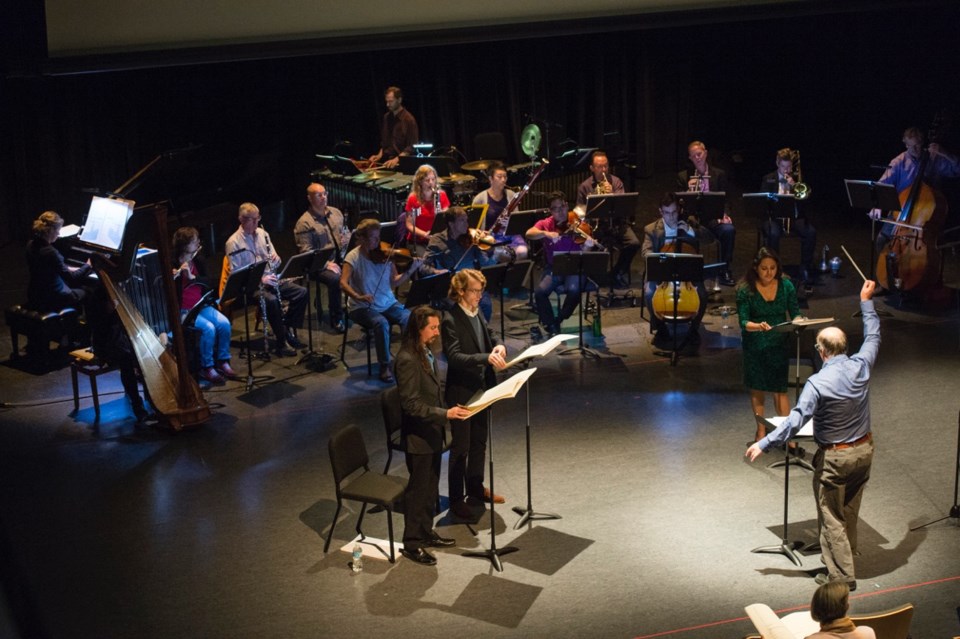On June 23, 1985, Air India Flight 182 disappeared off air traffic control radar near the coast of Ireland with 329 passengers and crew bound for Delhi.
As initial Irish search and rescue efforts turned to the grim task of recovery, news of the Air India disaster was just reaching a small family on Dublin Street in New Westminster, B.C. For them, the fate of an aunt and uncle and a young son waiting for them at home in India, began unfolding live on television. For the people of Cork, however, the Irish county closest to where the wreckage of the plane now lay scattered across the ocean, the tragedy was unfolding before their very eyes.
“People didn’t really know initially why this had happened,” says Jürgen Simpson, a Dublin-born composer and Air India researcher. “In many ways the initial response of people here in Ireland was really just a response to experiencing that degree of loss off the Irish coastline.”
In 1985, the cause was almost unheard of. That morning, as it travelled through Irish airspace at an altitude of 31,000 feet, Air India Flight 182 was destroyed by a bomb. All 329 Canadians, Indians, Americans and Britons on board were killed, including 82 children. Some were killed instantly, others died of hypoxia (lack of oxygen), while still more died of drowning in the sea below. Entire families were lost in the disaster. And, earlier the same day, a second bomb meant for another Air India flight went off prematurely at Narita International Airport in Tokyo, killing two baggage handlers and bringing the total death toll of the attack to 331.

Flight 182 was the largest mass murder in Canadian history, the first time a jumbo jet had ever been bombed, and the deadliest terror attack involving a plane until the events of Sept. 11, 2001. The bomb’s journey began in the cargo hold of a connecting flight from Vancouver and killed 280 Canadians when it ultimately detonated on the flight out of Montreal. The suspects — Sikh separatists operating in British Columbia — had been under surveillance by Canada’s intelligence agency, CSIS, for months before the flight was downed. Yet the loss of lives and bungled investigation was largely treated as a non-Canadian issue and wiped from the collective consciousness.
It was instead acknowledged most eloquently in Ireland, where Irish seamen aboard naval ships, merchant ships and fishing trawlers entered shark-infested waters to find what they could, and families from around the world filled the halls of the small county hospitals to identify the 131 bodies that were recovered.
Within the year, the people of Ahakista and Bantry in County Cork would start a grassroots fundraising campaign to build an Air India memorial along their coast.
“I think Ireland was wishing to embrace the tragedy and embrace the people affected by it,” says Simpson, who was just 10 at the time of the bombing. Cork, in 1985, had never seen that kind of influx of ethnicities says Simpson, and people with brown skin were a rare sight.
“There was a gorgeous quote from one of the newspapers back in 1985,” Simpson recalls, “telling the children that if they see people on the street who look strange, they should bring them flowers.”
For days after, children could reportedly be seen on sidewalks carrying dandelions bound up in tin foil.
Thirty years later, Air India family members still come to the lovingly tended, windswept overlook of the Ahakista memorial to mourn their dead and spend time with the people who quietly, gracefully witnessed their grief.
And, over the past seven years, Simpson has been working on commissions to create an artistic response to what happened in this community — what it must have been like to welcome grief-stricken strangers to the furthest edges of Europe. He says he struggled to find a way to express the full scope of the tragedy, though, until a book arrived in the mail filled with the words of Vancouver poet Renée Sarojini Saklikar.
Saklikar was 23 when she lost her aunt Zebunnisa and uncle Umar to the Air India disaster. The couple, both doctors, had been in America for a medical conference and decided to spontaneously visit their relatives in Vancouver for the first time. They then decided to leave early because they missed their young son, placing them on the fatal flight home.
Only her aunt’s body was ever found.
For years afterward, Saklikar says she and her parents avoided talking about the tragedy. She is still reticent to discuss the morning they heard the news, calling her memories of that day sacred.
Saklikar, who is married to B.C. NDP leader Adrian Dix, was born in India but came to Canada with her family when she was just a few months old. After living in a number of cities back east, they ultimately settled in New Westminster, where her father distinguished himself as a United Church minister and school trustee.
It wasn’t until his sudden death in 2002 that Saklikar, by then a lawyer and businesswoman, finally began writing.
“I think with so many people the way they come to writing, sadly, is through trauma,” says Saklikar, now a creative writing instructor at SFU.
After her father’s death, she joined a creative writing program and over the next few years began chronicling her life through poetry. When she reached 1985, though, she couldn’t move forward.
“I was writing essentially a memoir,” she recalls, “and once I got to 1985 that silencing again kicked in. I didn’t want to talk about it, didn’t want to write about it — I just wanted to write around it. And of course the more I tried to write around it, the more I couldn’t write anything.”
Eventually, her desire to write “overpowered everything else,” and she created children of air india: un/authorized exhibits and interjections, published in 2013 by Nightwood Editions. The collection of documentary-style poems — through painstakingly researched detail and jarringly real and imagined scenarios — paints a devastating portrait of the people whose lives were forever altered by the blast.
As you explore the book, which was a finalist for the Dorothy Livesay Poetry Prize and won the 2014 Canadian Authors Association Award for Poetry, thousands of official documents and memories are rendered into fragments of exhibits, courtrooms, living rooms, lives. Children’s laughter flutters the pages forward and unflinching language forces you to put it down.
There is anger in every use of italics, advocacy in every redacted name — the private ordeal becoming a painful matter of public record. For that reason, her own perspective is largely written out of the book, hinted at only in the narrator, N (for Niece), and the legal overtones of some of the passages. In fact, the only name that does survive in the book is that of Saklikar’s orphaned cousin Irfan, who is now in his 30s with two children of his own.
“You come up against the limitations of art when you deal with a horrific tragedy,” says Saklikar, who last week was named the inaugural poet laureate for Surrey. “There is that very famous German philosopher, [Theodor] Adorno, who said that after the Holocaust all poetry is obscene. So I think any poet of any merit has to struggle with that. But I reject [Adorno]. I think it’s a very good caution against sentiment, but in the end, for me, witnessing is important. This became an act of witness.”
And now, on Nov. 6, Vancouver can share in that act anew; with poems from children of Air India making their world premiere at the SFU Goldcorp Centre for the Arts in an operatic theatre piece entitled air india [redacted].
Just under two years prior, in a moment of pure inspiration, an audience member at one of Saklikar’s readings bought a copy of her book and sent it to Jürgen Simpson in Ireland.
That audience member was Owen Underhill, artistic director and conductor of the Turning Point Ensemble in Vancouver, who had been keeping up with his Irish friend and colleague’s efforts regarding Air India over the years.
Simpson says he knew right away that Saklikar’s text was the final key to capturing the Canadian, Irish and Indian perspectives in one.
All three artists joined forces and began working on air india [redacted] alongside Irish theatre and opera director Tom Creed and visual artist John Galvin.
“In a way, it’s a response to a response to a response,” says Creed of the project’s layers. “Renée’s poetry really unlocks a kind of anger; when you read the words on the page there’s a ferocity to it. It really bears witness to the personal experience of these people, the frustration of sitting in the courtroom with high-tech technology to protect the witnesses, which was more sophisticated than the technology at the airport.”
Using a blend of theatre, voice, poetry and visual projections, air india [redacted] transports the viewer to select moments before, during, and after the bombing.
“In a really poetic and not explicit way,” adds the Cork-born Creed. “It also conjures up elements of being in the air, being in the water, and the music attempts to ask ‘How do we deal with this tragedy, how do we prevent this?’”
“We live in a world today where such acts of terror are unfortunately much more common than they were at the time,” he continues, pointing to Malaysian Airlines Flights 370 and 17, which both went down while the project was underway.
“In a poem at the heart of Renée’s book and as a kind of centrepiece to air india [redacted], Renée positions Air India as a continuum of these acts of violence as you move through history,” says Creed.
Working with a $200,000 budget, air india [redacted] marks the most ambitious work of any of the collaborators’ careers to-date, and showcases not only Saklikar’s poetry, but the 16 acclaimed musicians of Turning Point Ensemble (celebrating its 10th anniversary this season) as well as the vocal talents of Canadian soprano Zorana Sadiq, countertenor Daniel Cabena and baritone Alexander Dobson.

Together they hope to shine a “glimmer of light” on the injustices of the protracted judicial process, which became the most expensive trial in Canadian history, costing nearly $130 million and ending with acquittals in 2005, as well as why some tragedies are deemed “more worthy of attention” than others.
“It took a long time to find a way of doing this that I could feel was appropriate to the complexity of the events,” says Simpson. “It’s impossible to find closure here, so the artistic response is about enabling meditation on these events and finding a balance between their human perspective and the social, legal and ultimately troubling conflicts that caused these events to occur.”
• air india [redacted] runs Nov. 6-11 at the SFU Goldcorp Centre for the Arts (149 W. Hastings). Tickets start at $29; for more information, go to TurningPointEnsemble.ca
Note: This story first appeared in the Westender. For more arts and culture news go to westender.com
![Vancouver poet Renée Saklikar, who lost family in the bombing of Flight 182, lends her words to 'air india [redacted]' – a musical theatre experience running Nov. 6-11 at the SFU Goldcorp Centre for the Arts. Photo Dan Toulgoet](https://www.vmcdn.ca/f/files/glaciermedia/import/lmp-all/792159-we-air-india-horiz-1131.jpg;w=960;h=640;bgcolor=000000)


